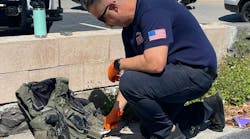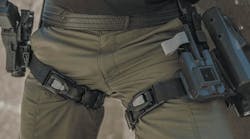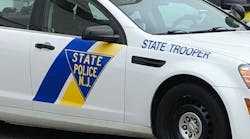CROFTON, Md., Sept. 12, 2018—As wildfires rage around the world, the International Association of Arson Investigators has just released a white paper on Fire Investigator Health and Safety Best Practices. The paper was produced by the organization’s Health and Safety Committee, reestablished in 2016 after recognizing that health and safety practices and protocols have not kept pace with that of firefighters.
“Though they rarely receive the recognition of firefighters, fire investigators are typically at more fires than firefighters and for a longer time,” explained Jeff Pauley, chairman of the IAAI Health and Safety Committee and a fire investigator. “The health and safety dangers of arson and fire investigators are often greater than that of firefighters.” This is because firefighters typically arrive to fires prepared to combat a blaze where fire investigators may arrive several days later, with less safety preparation, and assuming that, because the fire is extinguished, the danger is diminished.
And, while wildfires are a huge problem, the large number of everyday fires in communities remain a significant threat. Investigators are often on the scene of fires that are still active or scenes that are still hot from fire. Many develop chronic health issues including respiratory conditions. “Exposure to vapors, gasses and particulates can lead to a variety of dangerous health issues,” said Pauley. “Particulates are one of the biggest problems. Dust masks do very little to protect people from inhaling particulates.” He mentioned numerous seasoned firefighters who now have stage 4 cancer—a danger for fire investigators as well.
Fire Investigator Health and Safety Best Practices provides detailed information on the types of protections to use in various fire scenarios. Protection is of greatest need for hot scenes and there are two types described in the white paper—one where the fire has been extinguished but overhaul has not yet commenced or is in process and, a second scenario where the fire has been fully extinguished but for less than two hours. Both of these scenes are of greatest danger for fire investigators because of the potential for high levels of gases and particulates, e.g. smoldering items. A vetted NIOSH respirator is recommended along with a list of turnout gear and structural fire fighter gloves.
A warm scene is considered to be an area where the fire has been extinguished at least two hours prior but less than 72 hours. This is the typical time frame when many fire investigators find themselves on the scene. This is also a dangerous time for exposure including toxic chemicals and many of the same protections from the hot scene are recommended. A cold scene is a where a fire was extinguished at least 72 hours before. While research indicates that particulate and gas hazards are greatly reduced after 72 hours, when debris is disturbed (such as digging through the scene), the hazards rise. Even the mere act of walking through the scene can stir up particulates and gases. For this reason, respiratory protection is recommended.
Other dangers to fire investigators include skin exposure to chemicals and contaminants. Research has determined that firefighters have a greater incidence of skin cancer due to exposure and fire investigators have the same exposure rates. The white paper includes protocol for conducting a site safety survey of the entire scene before beginning work and recommends checking ahead of time to see if there are any known hazardous materials present, including asbestos as well as other physical and biological hazards. Using air quality monitoring equipment during all interior and exterior examinations is recommended along with monitoring for carbon monoxide, hydrogen cyanide, and hydrogen sulfide. Powered ventilation fans are recommended to move gases and vapors. Proper respiratory equipment should always be used.
The white paper states that it’s important, following the exposure to a fire scene, to remove all soot-covered clothing and, using soap and water or cleaning wipes, clean all skin areas that may have been exposed to soot contamination. Clean tools and respiratory assembly immediately and do not transport contaminated clothing in the vehicle’s passenger compartment. If this isn’t possible, all items should be placed in a sealed container.
“Some investigators mistake a cold fire scene as a safe fire scene,” added Pauley. “Many overlook the dangers that are there—even in those circumstances where the scene doesn’t appear to have any particulates or hazards.”
Pauley also advises the public to exercise extreme caution when returning to the scene of a fire. “Homeowners are often anxious to get to the scene and gather their belongings,” he stated. “They too are at risk of exposure to dangerous toxins, gases and particulates.”
Educating the public and fire investigators on health and safety protocols after a fire, is important to ensuring fewer incidences of chronic and life-threatening health conditions and illnesses caused by exposure.
# # #
About the International Association of Arson Investigators
The IAAI officially launched when it was established in 1949 in Kentucky as a nonprofit organization formed to meet the need and necessity of training and educating in the newly identified field of fire and arson investigation. Since that time, the association has grown into an international organization representing fire investigators around the globe. The mission of the IAAI is to provide active support to fire, arson and explosion investigation professionals through leadership in education, training, professional development, certification, networking, advocacy and the provision of resources. For more information, go to www.firearson.com.


